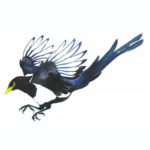Birds and wildlife have adapted to utilize native plants that provide food, cover, nesting sites or a combination of resources. Native plants provide food at different times of the year to birds in the form of seeds, fruit or as invertebrate host sites. The growth habits of native plants present recognizable, safe nesting sites and cover that protect birds from inclement weather and predation. The importance of these plants to birds, insects and other wildlife cannot be overstated.
Using native plants in your backyard landscape will offer the most resources to birds and wildlife and serve as rewarding attractants. On these pages you will find some examples of plants that are particularly valuable to specific birds and other beneficial organisms. A more comprehensive database with regional references is in the works at Audubon At Home and will be available online in the near future.
Plantings for birds in our area:
Nuttall’s Woodpecker, Oak Titmouse, Yellow-rumped Warbler- California Live Oak
Wrentit, California Towhee, Spotted Towhee – California Wax Myrle
For more information about native plants please visit:
California Native Plant Society
Master Gardener’s Program in San Joaquin County
Plants for Beneficial Insects
Predators. Parasitoids. Pollinators.
Welcome them into your Healthy Yard.
These are the insects, bugs and other organisms on the front line of pest control in your yard, guarding against destructive bugs and helping plants reproduce. Nature supplies these beneficial bugs of course, but you can encourage them to remain in your yard by providing them with some essential elements.
Nearly every plant in a natural environment will sustain at least some damage by pests…it is part of the natural balance. But pests don’t overpopulate a natural ecosystem due to the presence of natural enemies. In a healthy yard with its native plants and pesticide-free environment, pests will appear—and so will natural enemies.
THE INSECTS – Wild Friends, Natural Enemies
 |
| Ladybug feeding on cottonwood leaf beetle eggs, photo by James Solomon, USDA Forest Service |
Move Over, Lady – It has long been known that ladybugs (or lady beetles), especially in their larval stage, are “good bugs” with voracious appetites for aphids. Without dismissing the value of ladybugs as garden friends, there are other natural pest enemies that are much less conspicuous but even more valuable. The lowly “gnat” that flies by your ear may in fact be the tiny eulophid wasp – a full-grown one is just one-eighth inch – on her way to lay up to one hundred eggs in the pupae of tree-destroying beetles.
Predatory and parasitoid flies and wasps are key players in the biological control of insect pests. Many, in fact, are reared in laboratories and dispersed into crops, forests and neighborhoods to control exotic insect pests (i.e. elm leaf beetle). Click on the link below to learn more about the tiny denizens of your yard and other beneficial organisms.
THE PLANTS – Nectar for Natural Pest Enemies
 |
| Syrphid (hover) Fly, photo by Carl Dennis, Auburn University |
Nectar is an important dietary supplement for beneficial wasps and flies. Asters and their cousins (such as daisies and goldenrod) offer excellent resources and there are native varieties in every part of the country. Flowers that are composites – where many small symmetrical flowers occur in a central disk – are perfect for small wasps and flies such as the common predaceous hover fly (pictured left). Many of the beneficial insects are small and require a short flower structure in order to access the nectar.
These same flowering plants will attract a wide range of important pollinators such as native bees, butterflies and honeybees. When they produce seed, these plants will provide a valuable food source for birds and other wildlife in the fall and winter.
Plant a variety of plant types such as groundcover, trees, and shrubs, mimicking natural growth patterns to form complex habitat that will be home to a greater variety of beneficial insects.
THE INSECTS – Information and pictures of the lesser-known but effective natural enemies that occupy your backyard.
PLANTS TO ATTRACT BENEFICIAL INSECTS – Your guide to some stellar examples of the useful plants that will attract a variety of beneficial insects. Look for examples of similar native flowers occurring in your region.
Aster
Buckwheat
Coneflower
Coreopsis
Goldenrod
Ironweed
Joe-pye Weed
Sunflower
For more information about beneficial insects please visit:
Beneficial Insects in Your Garden
SIALIA
If you’re interested in finding out what rare and unusual birds are being seen in California (or anywhere in the US, for that matter), you should check out Sialia, aka The Birding Lists Digest. Sialia (http://digest.sialia.com) was created to help birders find out “what’s going on lately” in various regions of the U.S. with a minimum of hassle. The Digest automatically compiles all posts to dozens of birding email lists and organizes them by region, by day, and by list. Birders can view the current day’s messages, or browse messages from the last 30 days. This system allows birders to find information about rare bird sightings and other goings-on around the country in a timely and efficient manner. Check it out!
